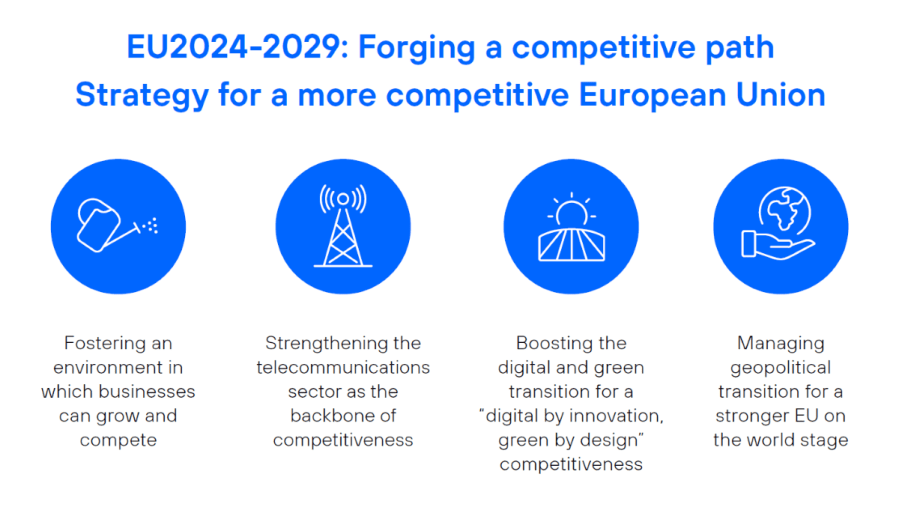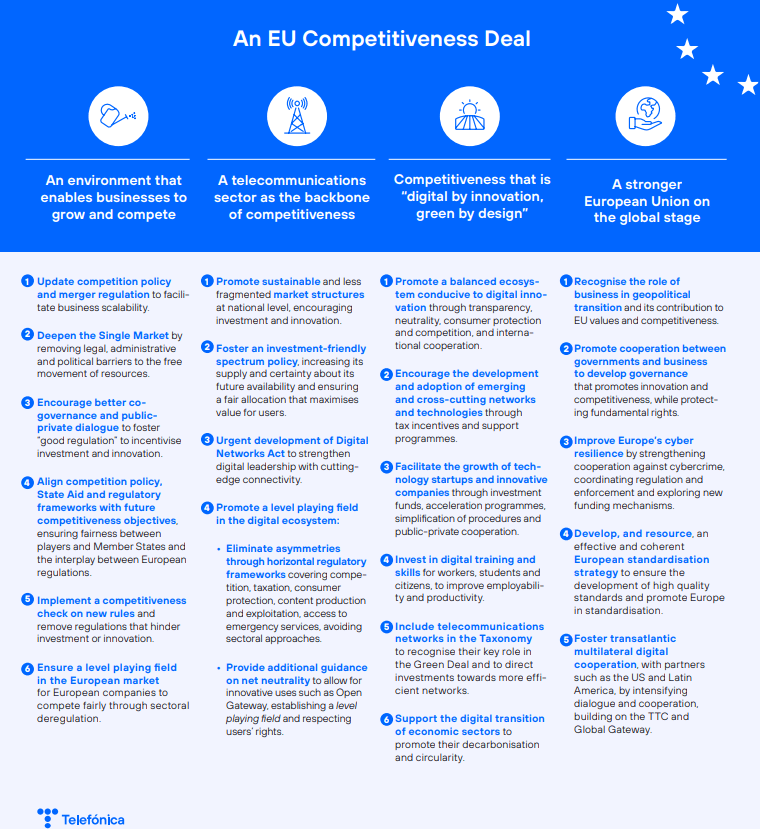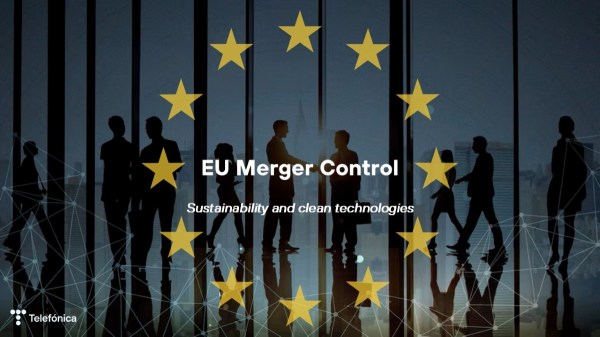Competitiveness will undoubtedly be at the forefront of policy and legislative initiatives in the EU during the 2024-2029 cycle. The reports on the State of the Single Market, presented by Enrico Letta in April 2024, and on the Future of European Competitiveness, presented by Mario Draghi in September, highlight the need for prompt action and will play a pivotal role in guiding the next European legislature.
In this context, our series, “EU2024-2029: Boosting Competitiveness,” sets out Telefónica’s vision for enhancing competitiveness and improving the EU’s global position. Specifically, we have analyzed the current state of competitiveness, emphasizing the need for a regulatory framework that fosters investment and innovation, and consolidates a competitive telecommunications sector. This is essential for the successful achievement of the triple transition: digital, green, and geopolitical, enhancing resilience and economic security.
With this final publication, we conclude the series, sharing our vision for Europe beyond 2030.
Forging a competitive path: An Urgent Call to Action
The challenge of competitiveness is an issue that cannot be delayed. In the report The Future of European Competitiveness, Mario Draghi emphasizes the need for Europe to accelerate its capacity for innovation in order to close the gap with the United States and China and invest between 750 and 800 billion euros per year, or 4% to 5% of its GDP. If it fails to do so, he warns, Europe risks facing a “slow agony”.
Draghi highlights that the primary objective of a competitiveness agenda should be to promote productivity, which is the key driver of long-term growth and improvements in welfare. Additionally, he identifies the telecommunications sector as a crucial industry for boosting productivity and driving economic growth in the region.
In line with this vision, in the document “EU 2024-2029: Driving Competitiveness. Digital by Innovation, Green by Design” Telefónica underscores the fundamental role of the telecommunications sector in building a more competitive, resilient, and prosperous Europe. Telefónica therefore advocates for a robust EU competitiveness deal that fosters a favorable environment for investment and innovation.

How do we imagine Europe beyond 2030?
Looking to the future, and as a result of an effective competitiveness strategy, we envision a more competitive and resilient Europe, prepared to tackle global challenges, with a solidified leadership position in digital innovation and sustainability, and a focus on the well-being of its citizens.
In our vision, Europe beyond 2030 will have succeeded by:
1. Promoting an environment that enables businesses to grow and compete:
Europe succeeds in transforming regulation from a barrier to a competitive advantage. Simplified regulation and a more coherent framework, aligned with the needs of both businesses and society, create an environment that enhances investment and innovation capacity of European companies, particularly in the telecommunications sector.
This flexibility allows EU companies to bridge the scale gap with their counterparts in regions like the United States, enabling them to compete effectively and on a level playing field across all sectors and markets, at the national, regional, and global level.
A more flexible regulatory environment prevents the relocation of investment, talent, and business decision-making centres outside the EU, thereby strengthening the region’s economic security. It also encourages innovation and the development of key sectors and technologies crucial for competitiveness, such as artificial intelligence and 5G, boosting the region´s global relevance.
2. Strengthening the telecommunications sector as the backbone of competitiveness:
This vision for Europe beyond 2030, entails the active support of public policies for the deployment and modernization of fixed and mobile networks. This will provide state-of-the-art infrastructure that drives 21st-century innovation and enhances the well-being of its citizens.
The Digital Networks Act is a key priority for Europe with the goal of fostering investment by simplifying ex-ante regulation, promoting market structures that ensure the profitability of investments, and creating a more balanced digital ecosystem where regulatory disparities between providers of similar services are eliminated. This approach reinforces the competitiveness and sustainability of the telecommunications sector, enhancing the connectivity ecosystem for the benefit of the citizens, the economy, and the resilience of Europe.
3. Driving competitiveness “digital by innovation, green by design”:
Digital by innovation
Europe’s innovation-driven digital transformation provides a favorable environment for the development of digital services and technologies “made in Europe.” This environment is characterized by advances in emerging technologies, the digitalization of European businesses, the development of the technological skills necessary to ensure employability, and the promotion of a more balanced and fair digital ecosystem.
The result is a Europe with stronger companies, supported by a skilled workforce, a start-up ecosystem with high scalability potential, and an attractive environment for further investment in innovation. This transformation also has a positive impact on society, creating new employment opportunities and an improving the standard of living.
Green by design
By refocusing its strategy on simplifying regulatory frameworks and harmonizing methodologies, Europe beyond 2030 restores the link between sustainability and competitiveness. This shift enables the region to move beyond its traditional approach to decarbonization, which had led to fragmented impact assessment methodologies, excessive reporting obligations, and disincentives for voluntary sustainability initiatives by companies.
Leveraging the opportunities offered by connectivity and new technologies, Europe fosters a smarter and more competitive economy. This approach allows companies to optimize resources, reduce their environmental impact, improve productivity, and strengthen their market position.
4. Building a stronger EU on the global stage:
Europe is enhancing its international relevance and promoting its core values of well-being, security, and privacy through the growth of innovative, digital, and sustainable businesses. Furthermore, it encourages a fair and competitive environment, ensuring shared responsibility with the technology companies that currently hold a dominant position in the global landscape.
In the context of the geopolitical transition, Europe is pursuing a policy of enhanced cooperation and solidarity, with a view to strengthening bilateral and multilateral relations. This allows the region to diversify its resources and secure critical supplies for its digital and green transformation, while also contributing to the economic and social development of other regions. Furthermore, Europe is strengthening its position as a leader within international organizations and in the development of technology standards, reducing fragmentation and driving innovation.
Furthermore, in light of the growing risks from sophisticated cyber-attacks due to advances in technologies such as AI and quantum computing, Europe is enhancing its resilience by partnering with strategic players such as telecommunications operators.
This vision of Europe’s future may seem utopian, but it is not beyond reach. The success of this vision will depend on the clarity and strategic foresight with which policymakers in the 2024-2029 European cycle implement the policy and legislative initiatives necessary to drive progress towards the Europe we aspire to beyond 2030.










